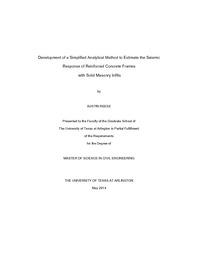
ATTENTION: The works hosted here are being migrated to a new repository that will consolidate resources, improve discoverability, and better show UTA's research impact on the global community. We will update authors as the migration progresses. Please see MavMatrix for more information.
Show simple item record
| dc.contributor.author | Reese, Austin | en_US |
| dc.date.accessioned | 2014-07-14T20:30:47Z | |
| dc.date.available | 2014-07-14T20:30:47Z | |
| dc.date.issued | 2014-07-14 | |
| dc.date.submitted | January 2014 | en_US |
| dc.identifier.other | DISS-12720 | en_US |
| dc.identifier.uri | http://hdl.handle.net/10106/24484 | |
| dc.description.abstract | This thesis discusses the analysis of the lateral force-vs-drift relation of reinforced concrete (RC) frames with masonry infill panels under in-plane lateral loads. Such structures have been the topic of several studies due to their recurring catastrophic failures during seismic events. Due to the large number of variables that can affect their seismic performance and lead to various possible failure mechanisms there is no widely accepted method for the assessment of the structural behavior of infilled frames under seismic loads. A parametric study was performed here using detailed analytical models which provided insight to the influence of the various design parameters and material properties. The observations from the parametric study and selected experimental studies were taken into account in the development of a simplified procedure that is proposed here for the estimation of the force-vs-drift behavior of infilled frames. With the proposed method, the force-vs-drift curve for an infilled RC frame can be estimated based on the frame geometry, reinforcing details, and basic material properties. The simplified method is based upon the prediction of the expected failure pattern for an infilled frame which can be achieved using some simple to apply criteria based on the relative shear and flexural strengths of the frame and infill. Four classes have been proposed ranging from strong infill- strong frame cases to weak infill- weak frame. Each class tends to develop a different failure pattern that may include plastic hinges and/or shear failures in the columns as well as diagonal sliding and/or cracking of the infill. The framework has been validated with data from experimental and analytical studies on single-bay, single-story specimens with a wide range of geometries, design details, and material properties. The comparison of the analytical and experimental results indicates that the proposed methodology, although simplified, it can successfully capture the main features of the seismic response of infilled frames, including the initial stiffness as well as the strength and drift at the apparent yield point, peak load and onset of residual capacity. | en_US |
| dc.description.sponsorship | Stavridis, Andreas | en_US |
| dc.language.iso | en | en_US |
| dc.publisher | Civil & Environmental Engineering | en_US |
| dc.title | Development Of A Simplified Analytical Method To Estimate The Seismic Response Of Reinforced Concrete Frames With Solid Masonry Infills | en_US |
| dc.type | M.S. | en_US |
| dc.contributor.committeeChair | Stavridis, Andreas | en_US |
| dc.degree.department | Civil & Environmental Engineering | en_US |
| dc.degree.discipline | Civil & Environmental Engineering | en_US |
| dc.degree.grantor | University of Texas at Arlington | en_US |
| dc.degree.level | masters | en_US |
| dc.degree.name | M.S. | en_US |
Files in this item
- Name:
- Reese_uta_2502M_12720.pdf
- Size:
- 4.261Mb
- Format:
- PDF
This item appears in the following Collection(s)
Show simple item record


